African American literature
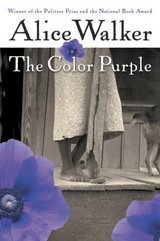 African American literature is literature written by, about, and sometimes
specifically for African Americans. The genre began during the 18th and 19th centuries with writers such as poet Phillis Wheatley and
orator Frederick Douglass, reached an early high point with the Harlem Renaissance, and continues today with authors such as Toni Morrison and Maya Angelou
being ranked among the top writers in the United States. Among the
themes and issues explored in African American literature are the role
of African Americans within the larger American society, African
American culture, racism, slavery, and equality. African American literature is literature written by, about, and sometimes
specifically for African Americans. The genre began during the 18th and 19th centuries with writers such as poet Phillis Wheatley and
orator Frederick Douglass, reached an early high point with the Harlem Renaissance, and continues today with authors such as Toni Morrison and Maya Angelou
being ranked among the top writers in the United States. Among the
themes and issues explored in African American literature are the role
of African Americans within the larger American society, African
American culture, racism, slavery, and equality.
As African Americans' place in American society has changed over the
centuries, so too has the focus of African American literature. Before
the American Civil War, African American literature primarily focused on the
issue of slavery, as indicated by the popular subgenre of slave narratives. At the turn of the 20th century, books by authors such as W.E.B. DuBois and Booker T. Washington debated
whether to confront or appease racist attitudes in the United States. During
the American Civil Rights movement, authors like Richard Wright and Gwendolyn Brooks wrote
about issues of segregation and black nationalism. Today, African American literature
has become accepted as an integral part of American literature, with books in the genre, such as Roots: The Saga of an American Family by Alex Haley and The Color Purple by Alice Walker, achieving both best-selling and award-winning status.
Characteristics
African American literature tends to focus on themes of interest to Black
people, such as the role of African Americans within the larger American society
and issues such as African American culture, racism, religion, slavery, freedom,
and equality. This focus began with the earliest African American writings,
such as the slave narrative genre in the early 19th century, and continues through the work of many current-day authors.
Another characteristic of African American literature is its strong
tradition of incorporating oral poetry into itself. There are many
examples of oral poetry in African American culture, including spirituals, African
American gospel music, blues and rap. This oral poetry also shows up in the African
American tradition of Christian sermons,
which make use of deliberate repetition and cadence. All of these
examples of oral poetry have made their way into African-American
literature.
However, while these characteristics exist on many levels of African
American literature, they are not the exclusive definition of the
genre. As with any type of literature, there are disagreements as to
the genre's definitions and which authors and works should be included.
For example, some people include in African American literature
writings which lack African American characters and situations and are
not particularly targeted at Black audiences. An example of this is the
outspokenly gay science fiction writer Samuel R. Delany,
who, while not writing specifically about African American issues, is
considered by many to be a leading voice in African American literature.
back to top
History
Early African American literature
Just as African American history predates the emergence of the United States as an independent country, so too does African American literature have similarly deep roots.
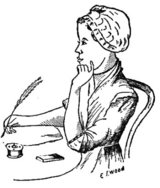 The
first prominent African American author, poet Phillis
Wheatley (1753-1784 - see picture right), published her book Poems
on Various Subjects in
1773, three years before American independence. Born in Senegal, Africa, Wheatley
was captured and sold into slavery
at the age of 7. Brought to America, she was owned by a Boston
merchant. Even though she initially spoke no English, by the time she
was sixteen she had mastered the language. Her poetry was praised by
many of the leading figures of the American Revolution, including George Washington,
who personally thanked her for a poem she wrote in his honor. Despite
this, many white people found it hard to believe that a Black woman
could be so intelligent as to write poetry. As a result, Wheatley had
to defend herself in court by proving she actually wrote her own
poetry. Some critics cite Wheatley's successful defense as the first
official recognition of African American literature.[1] The
first prominent African American author, poet Phillis
Wheatley (1753-1784 - see picture right), published her book Poems
on Various Subjects in
1773, three years before American independence. Born in Senegal, Africa, Wheatley
was captured and sold into slavery
at the age of 7. Brought to America, she was owned by a Boston
merchant. Even though she initially spoke no English, by the time she
was sixteen she had mastered the language. Her poetry was praised by
many of the leading figures of the American Revolution, including George Washington,
who personally thanked her for a poem she wrote in his honor. Despite
this, many white people found it hard to believe that a Black woman
could be so intelligent as to write poetry. As a result, Wheatley had
to defend herself in court by proving she actually wrote her own
poetry. Some critics cite Wheatley's successful defense as the first
official recognition of African American literature.[1]
Another early African American writer is William Wells Brown (1814-1884).
Brown was a prominent abolitionist, lecturer, novelist, playwright, and historian.
Born into slavery in the Southern United States,
Brown escaped to the North, where he worked for abolitionist causes and
was a prolific writer. Brown wrote what is considered to be the first
novel by an African American, Clotel; or, The President's Daughter (1853).
The novel is based on what was at that time considered to be a rumor about Thomas
Jefferson fathering a daughter with his slave, Sally Hemings.
However, because the novel was published in England, the book is not
considered the first African American novel published in the United
States. This honor instead goes to Harriet Wilson, whose novel, Our Nig (1859), details the difficult lives of Northern free Blacks.
Slave narratives
A subgenre of African American literature which began in the middle
of the 19th century is the slave narrative. At the time, the
controversy over slavery led to impassioned literature on both sides of the issue, with books like Uncle Tom's Cabin
(1852) representing the abolitionist view of the evils of slavery,
while the so-called anti-Tom novels by white, southern writers like William Gilmore Simms represented
the pro-slavery viewpoint.
To present the true reality of slavery, a number of former slaves such as Harriet Jacobs and Frederick Douglass wrote
slave narratives, which soon became a mainstay of African American literature.
Some six thousand former slaves from North America and the Caribbean wrote accounts of their lives, with about 150 of these published as separate books or pamphlets.
Slave narratives can be broadly categorized into three distinct
forms: tales of religious redemption, tales to inspire the abolitionist
struggle, and tales of progress. The tales written to inspire the
abolitionist struggle are the most famous because they tend to have a
strong autobiographical motif. Many of them are now recognized as the
most literary of all 19th-century writings by African Americans, with
two of the most well-known being Frederick Douglass's autobiography and
Incidents in the Life of a Slave Girl by Harriet Jacobs (1861).
Frederick Douglass
- See Link: Frederick
Douglass
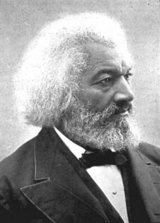 While
Frederick Douglass (c. 1818-1895) first came to public
attention as an orator and as the author of his autobiographical slave
narrative, he eventually became the most prominent African American of
his time and one of the most influential lecturers and authors in
American history. While
Frederick Douglass (c. 1818-1895) first came to public
attention as an orator and as the author of his autobiographical slave
narrative, he eventually became the most prominent African American of
his time and one of the most influential lecturers and authors in
American history.
Born into slavery in Maryland, Douglass eventually escaped and
worked for numerous abolitionist causes. He also edited a number of
newspapers. Douglass' most well-known work is his autobiography, Narrative of the Life of Frederick Douglass, an American Slave, which
was published in 1845.
At the time some critics attacked the book, not believing that a black
man could have written such an eloquent work. Despite this, the book
was an immediate bestseller.
Douglas later revised and expanded his autobiography, which was republished as, My Bondage and My Freedom
(1855). In addition to serving in a number of political posts during
his life, he also wrote numerous influential articles and essays.
back to top
Post-slavery literature
After the end of slavery and the American Civil War, a number of
African American authors continued to write nonfiction works about the
condition of African Americans in the country.
Among the most prominent of these writers is W.E.B.
Du Bois (1868-1963), one of the original founders of the NAACP.
At the turn of the century, Du Bois published a highly influential collection
of essays titled, The
Souls of Black Folk.
The book's essays on race were groundbreaking and drew from DuBois's
personal experiences to describe how African Americans lived in
American society. The book contains Du Bois's famous quote: "The
problem of the twentieth century is the problem of the color-line."Du
Bois believed that African Americans should, because of their common
interests, work together to battle prejudice and inequity.
Another prominent author of this time period is Booker T. Washington (1856-1915), who in many ways represented opposite views from Du Bois. Washington was an educator and the founder of the Tuskegee Institute, a Black college in Alabama. Among his published works are Up From Slavery (1901), The Future of the American Negro (1899), Tuskegee and Its People (1905), and My Larger Education
(1911). In contrast to Du Bois, who adopted a more confrontational
attitude toward ending racial strife in America, Washington believed
that Blacks should first lift themselves up and prove themselves the
equal of whites before asking for an end to racism. While this
viewpoint was popular among some Blacks (and many whites) at the time,
Washington's political views would later fall out of fashion.
A third writer who gained attention during this period is Marcus
Garvey (1887-1940),
a publisher, journalist, and crusader for Black nationalism.
He is best known as a champion of Black nationalism and the
"back-to-Africa" movement, which encouraged people of African ancestry
to return to their ancestral homeland. He wrote a number of essays and
nonfiction books.
Even though Du Bois, Washington, and Garvey were the leading African
American intellectuals and authors of their time, other African
American writers also rose to prominence. Among these are Charles W. Chesnutt, a well-known essayist.
Harlem Renaissance
The Harlem Renaissance
from 1920 to 1940 brought new attention to African American literature.
While the Harlem Renaissance, based in the African American community
in Harlem in New York City,
existed as a larger flowering of social thought and culture—with
numerous Black artists, musicians, and others producing classic works
in fields from jazz to theatre—the renaissance is perhaps best known
for the literature that came out of it.
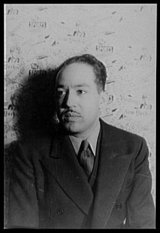 Among
the most famous writers of the renaissance is poet Langston
Hughes. Hughes (See photo right photographed by Carl
Van Vechten, 1936), first received attention in the 1922
poetry collection, The
Book of American Negro Poetry. This book, edited by James Weldon Johnson,
featured the work of the period's most talented poets (including, among others, Claude
McKay). In 1926, Hughes published a collection of poetry, The Weary
Blues, and in 1930 a novel, Not Without Laughter.
Hughes' most famous poem is "The Negro Speaks of Rivers."Until his
death in 1967, he published nine volumes of poetry, eight books of
short stories, two novels, and a number of plays, children's books, and translations. Among
the most famous writers of the renaissance is poet Langston
Hughes. Hughes (See photo right photographed by Carl
Van Vechten, 1936), first received attention in the 1922
poetry collection, The
Book of American Negro Poetry. This book, edited by James Weldon Johnson,
featured the work of the period's most talented poets (including, among others, Claude
McKay). In 1926, Hughes published a collection of poetry, The Weary
Blues, and in 1930 a novel, Not Without Laughter.
Hughes' most famous poem is "The Negro Speaks of Rivers."Until his
death in 1967, he published nine volumes of poetry, eight books of
short stories, two novels, and a number of plays, children's books, and translations.
The other famous writer of the renaissance is novelist Zora Neale Hurston, author of the classic novel, Their Eyes Were Watching God (1937).
Altogether, Hurston wrote 14 books which ranged from anthropology to short
stories
to novel-length fiction. Because of Hurston's gender and the fact that
her work was not seen as politically active, her writings fell into
obscurity for decades. Hurston's work was rediscovered in the 1970s in
a famous essay by Alice Walker, who found in Hurston a role model for all female African American writers.
While Hurston and Hughes are the two most influential writers to
come out of the Harlem Renaissance, a number of other writers also
became well known during this period. They include Jean Toomer, who wrote Cane, a famous collection of stories, poems, and sketches about rural and urban Black life, and Dorothy West, author of the novel, The Living is Easy,
which examined the life of an upper-class Black family. Another popular renaissance writer is Countee Cullen,
who described everyday Black life in his poems (such as a trip he made
to Baltimore, which was ruined by a racial insult). Cullen's books
include the poetry collections, Color (1925), Copper Sun (1927), and The Ballad of the Brown Girl (1927). Author Wallace Thurman also made an impact with his novel, The Blacker the Berry: A Novel of Negro Life (1929), which focused on intraracial prejudice between lighter-skinned and darker-skinned Blacks.
The Harlen Renaissance marked a turning point for African American
literature. Prior to this time, books by African Americans were
primarily read by other Black people. With the renaissance, though,
African-American writings—along with Black art and music such as
jazz—began to be absorbed into mainstream American culture.
back to top
Civil Rights Movement literature
A large migration of African Americans began during World War I, hitting its
high point during World War II. During this Great Migration, Black people left
the racism and lack of opportunities in the American South and settled in northern
cities like Chicago, where they found work in factories and other sectors of the economy.[2]
This migration produced a new sense of independence in the Black
community and contributed to the vibrant Black urban culture seen
during the Harlem Renaissance. The migration also empowered the growing
American Civil Rights movement,
which made a powerful impression on Black writers during the 1940s,
'50s and '60s. Just as Black activists were pushing to end segregation
and racism and create a new sense of Black nationalism, so too were
Black authors attempting to address these issues with their writings.
One of the first writers to do so was James Baldwin,
whose work addressed issues of race and sexuality. Baldwin, who is best known for his novel, Go Tell it on the Mountain,
wrote deeply personal stories and essays while examining what it was like to
be both Black and homosexual at a time when neither of these identities was accepted by American culture. In all, Baldwin wrote nearly 20 books.
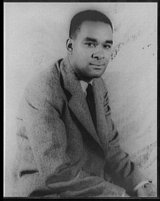 Baldwin's
idol and friend was author Richard
Wright (see photo left, photographed by Carl
Van Vechten, 1939), whom Baldwin called "the greatest Black writer
in the world for me". Wright is best known for his novel, Native
Son
(1940), which tells the story of Bigger Thomas, a Black man struggling
for acceptance in Chicago. Baldwin was so impressed by the novel that
he titled a collection of his own essays, Notes of a Native Son, in reference
to Wright's novel. However, their friendship fell apart when Baldwin later wrote
an essay criticizing Native Son for lacking credible characters and psychological
complexity. Among Wright's other book are the semi-autobiographical novel, Black
Boy (1945), The Outsider (1953), and White Man, Listen! (1957). Baldwin's
idol and friend was author Richard
Wright (see photo left, photographed by Carl
Van Vechten, 1939), whom Baldwin called "the greatest Black writer
in the world for me". Wright is best known for his novel, Native
Son
(1940), which tells the story of Bigger Thomas, a Black man struggling
for acceptance in Chicago. Baldwin was so impressed by the novel that
he titled a collection of his own essays, Notes of a Native Son, in reference
to Wright's novel. However, their friendship fell apart when Baldwin later wrote
an essay criticizing Native Son for lacking credible characters and psychological
complexity. Among Wright's other book are the semi-autobiographical novel, Black
Boy (1945), The Outsider (1953), and White Man, Listen! (1957).
The other great novelist of this period is Ralph Ellison, best known for his novel, Invisible Man,
which won the National Book Award in 1953. Even though Ellison did not complete another novel during his lifetime, Invisible Man was so influential that it secured his place in literary history. After Ellison's death, a second novel, Juneteenth, was pieced together from the 2,000-plus pages he had written over 40 years.
The Civil Rights time period also saw the rise of female Black poets, most notably Gwendolyn Brooks,
who became the first African American to win the Pulitzer Prize when it was awarded for her 1949 book of poetry, Annie Allen. Along with Brooks, other female poets who became well known during the 1950s and '60s are Nikki Giovanni and Sonia Sanchez.
During this time, a number of playwrights also came to national attention, notably Lorraine Hansberry, whose play, A Raisin in the Sun
focuses on a poor Black family living in Chicago. The play won the 1959
New York Drama Critics' Circle Award. Another playwright who gained
attention was Amiri Baraka, who wrote controversial off-Broadway plays.
It is also worth noting that a number of important essays and books
about human rights were written by the leaders of the Civil Rights
Movement. One of the leading examples of these is Martin Luther King, Jr.'s "Letter
from Birmingham Jail".
back to top
Recent history
Beginning in the 1970s, African American literature reached the
mainstream as books by Black writers continually achieved best-selling
and award-winning status. African American writers were also accepted
by academia, with numerous colleges and universities offering courses
in African American literature.[3]
Among the first books to top the bestseller lists was Roots: The Saga of an American Family by Alex Haley. The book, a fictionalized account of Haley's family history—beginning
with the kidnapping of Haley's ancestor Kunta Kinte in Gambia through his life as a slave in the United States—won
the Pulitzer Prize and became a popular television miniseries. Haley also wrote The Autobiography of Malcolm X in 1965.
In 1982, novelist and poet Alice Walker won
both the Pulitzer Prize and the American Book Award for her novel, The Color Purple.
An epistolary novel (a book written in the form of letters), The Color Purple tells
the story of Celie, a young woman who is sexually abused by her father and
then is forced to marry a man who physically abuses her. The novel was later
made into a film by Steven Spielberg.
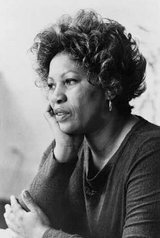 One
of the most important African American writers in recent years is Toni
Morrison (see photo, c.1977). As a New York editor in the 1960s and '70s,
Morrison helped promote Black literature. Her first novel, The Bluest Eye,
was published in 1970. Among her most famous novels is Beloved,
which won the Pulitzer Prize for Fiction in 1988.
This story describes a slave who found freedom, but killed her infant
daughter to save her from a life of slavery. Another important novel is
Song
of Solomon,
a tale about materialism and brotherhood. Morrison is the first African American
woman to win the Nobel Prize in Literature. One
of the most important African American writers in recent years is Toni
Morrison (see photo, c.1977). As a New York editor in the 1960s and '70s,
Morrison helped promote Black literature. Her first novel, The Bluest Eye,
was published in 1970. Among her most famous novels is Beloved,
which won the Pulitzer Prize for Fiction in 1988.
This story describes a slave who found freedom, but killed her infant
daughter to save her from a life of slavery. Another important novel is
Song
of Solomon,
a tale about materialism and brotherhood. Morrison is the first African American
woman to win the Nobel Prize in Literature.
Other important writers in recent years include literary fiction writers Gayl Jones, Ishmael Reed, Jamaica Kincaid, Randall Kenan, and John Edgar Wideman.
African American literature has also crossed over to genre fiction, such as the crime novels of Walter Mosley and science fiction of Samuel R. Delany and Octavia E. Butler. African American poets have also garnered attention, with Maya Angelou reading
a poem at Bill Clinton's inauguration, Rita Dove winning the Pulitzer Prize, and lesser-known poets like Thylias Moss and Natasha Trethewey being praised for their innovative work. Notable Black playwrights include Ntozake Shange, who wrote, For Colored Girls Who Have Considered Suicide/When the Rainbow is Enuf, Ed Bullins, and the prolific August Wilson, who has won two Pulitzer Prizes for his plays.
African American literature also has gained added attention through the work
of talk show host Oprah Winfrey,
who repeatedly has leveraged her fame to promote literature through the medium
of her Oprah's Book Club. At times, she has brought African American writers a far broader audience than they otherwise might have received.
back to top
Critiques
While African American literature is well-accepted in the United
States, it is not without controversy. To the genre's supporters,
African American literature exists both within and outside American literature and
is helping to revitalize the country's writing. To critics, African American
literature is part of a Balkanization
of American literature. In addition, there are some within the African
American community who do not like how their own literature sometimes
showcases Black people.
Existing both inside and outside American literature
According to James Madison University
English professor Joanne Gabbin, African American literature exists
both inside and outside American literature. "Somehow African American
literature has been relegated to a different level, outside American
literature, yet it is an integral part," she says.[4]
This view of African American literature is grounded, in many ways,
in the experience of Black people in the United States. Even though
African Americans have long claimed an American identity, during most
of United States history they were not accepted as full citizens. As a
result, they were part of America while also being outside it.
The same can be said for African American literature. While it
exists fully within the framework of a larger American literature, it
also exists as its own entity. As a result, new styles of storytelling
and unique voices are created in isolation. The benefit of this is that
these new styles and voices can leave their isolation and help
revitalize the larger literary world (McKay, 2004). This artistic
pattern has held true with many aspects of African American culture over the
last century, with jazz and hip hop
being just two artistic examples that developed in isolation within the
Black community before reaching a larger audience and eventually
revitalizing American culture.
Whether African American literature will keep to this pattern in the
coming years remains to be seen. Since the genre is already popular
with mainstream audiences, it is possible that its ability to develop
new styles and voices—or to remain "authentic," in the words of some
critics—may be a thing of the past.[5]
Balkanization of American literature?
Despite these views, some conservative
academics and intellectuals argue that African American literature only
exists as part of a so-called "balkanization" of literature over the
last few decades or as an extension of the culture
wars into the field of literature.[6] According
to these critics, literature is splitting into distinct and separate groupings
because of the rise of identity
politics
in the United States and other parts of the world. These critics reject
bringing identity politics into literature because this would mean that
"only women could write about women for women, and only Blacks about
Blacks for Blacks."[7]
People opposed to this group-based approach to writing say that it
limits the ability of literature to explore the overall human condition
and, more importantly, judges ethnic writers merely on the basis of
their race. These critics reject this judgement and say it defies the
meaning of works like Ralph Ellison's Invisible Man, in which Ellison's main character is invisible because people see him as nothing more than a Black man.[8]
Proponents counter that the exploration of group and ethnic dynamics
through writing actually deepens human understanding and that,
previously, entire groups of people were ignored or neglected by
American literature.[9] (Jay, 1997)
The general consensus view appears to be that American literature is
not breaking apart because of new genres like African American
literature. Instead, American literature is simply reflecting the
increasing diversity of the United States and showing more signs of
diversity than ever before in its history (Andrews, 1997) and (McKay,
2004). This view is supported by the fact that many African American
authors—and writers representing other minority groups—consistently
reach the tops of the best-seller lists. If their literature only
appealed to their individual ethnic groups, this would not be possible.
African American criticism
Some of the criticism of African American literature over the years
has come, surprisingly enough, from within the African American
community. This results from complaints that Black literature sometimes
does not portray Black people in a positive light.
This clash of aesthetics and racial politics has its beginnings in comments
made by W.E.B DuBois in the NAACP publication The Crisis.
For example, in 1921 he wrote, "We want everything that is said about
us to tell of the best and highest and noblest in us. We insist that
our Art and Propaganda be one." He added to this in 1926 by saying,
"All Art is propaganda and ever must be, despite the wailing of the
purists."[10] DuBois
and the editors of The Crisis consistently stated that literature was
a tool in the struggle for African American political liberation.
DuBois's belief in the propaganda value of art showed most clearly when he
clashed in 1928 with African American author Claude
McKay over McKay's best-selling novel, Home to Harlem.
To DuBois, the novel's frank depictions of sexuality and the nightlife
in Harlem only appealed to the "prurient demand[s]" of white readers
and publishers looking for portrayals of Black "licentiousness." DuBois
also said, "Home to Harlem ... for the most part nauseates me, and after
the dirtier parts of its filth I feel distinctly like taking a bath."[11] This
criticism was repeated by others in the Black community when author Wallace
Thurman published his novel, The Blacker the Berry,
in 1929. This novel, which focused on intraracial prejudice between
lighter-skinned and darker-skinned Blacks, infuriated many African
Americans, who did not like such a public airing of their culture's
"dirty laundry."[12]
Naturally, many African American writers did not agree with the
viewpoint that all Black literature should be propaganda, and instead
believed that it should present the truth about life and people. Langston
Hughes
articulated this view in his essay, "The Negro Artist and the Racial
Mountain" (1926), when he said that Black artists intended to express
themselves freely, no matter what the Black public or white public
thought.
A more recent occurance of this Black-on-Black criticism arose in charges by some critics that Alice Walker's novel, The Color Purple, unfairly attacked Black men.[13] Walker later refuted these charges in her book The Same River Twice: Honoring the Difficult.
back to top
Notes
- ^ Ellis
Cashmore, review of The Norton Anthology of African-American Literature, Nellie Y. McKay and Henry Louis Gates, eds., New Statesman, April 25, 1997 (accessed July 6, 2005).
- ^ David
M. Katzman, "Black
Migration," in The Reader's Companion to American History, Houghton Mifflin
Co. (accessed July 6, 2005); James Grossman, "Chicago
and the 'Great Migration'," Illinois History Teacher 3, no. 2 (1996),
(accessed July 6, 2005).
- ^ Ronald
Roach, "Powerful
pages—unprecedented public impact of W.W. Norton and Co's Norton Anthology
of African American Literature," Black Issues in Higher Education,
September 18, 1997 (accessed July 6, 2005).
- ^ "Coup
of the Century", James Madison University (accessed July 6, 2005).
- ^ See
note 1 above.
- ^ Theodore
Dalrymple, "An
imaginary 'scandal'," The New Criterion 23, no. 9 (May 2005); Richard
H. Brodhead, "On
the Debate Over Multiculturalism," On Common Ground , no. 7 (Fall
1996), (accessed July 6, 2005).
- ^ Dalrymple, "imaginary
'scandal'." (accessed July 6, 2005).
- ^ Paul
Greenberg, "I
hate that (The rise of identity journalism)," townhall.com, June 15, 2005
(accessed July 6, 2005).
- ^ Theodore
O. Mason, Jr., "African-American
Theory and Criticism," Johns Hopkins Guide Literary Theory & Criticism;
American Literature, College of Education, Cal State San Bernadino; Stephanie Y.
Mitchem, "No
longer nailed to the floor," Cross Currents, Spring 2003; Cashmore,
review of The
Norton Anthology of African-American Literature (accessed July 6, 2005).
- ^ Mason, "African-American
Theory and Criticism" (accessed July 6, 2005).
- ^ John
Lowney, "Haiti
and Black Transnationalism: Remapping the Migrant Geography of Home to Harlem," African
American Review, Fall 2000 (accessed July 6, 2005).
- ^ Frederick
B. Hudson, "Black
and Gay? A Painter Explores Historical Roots," The Black World Today,
April 25, 2005; Daniel M. Scott, "Harlem
shadows: re-evaluating Wallace Thurman's The Blacker the Berry," MELUS,
Fall-Winter 2004 (accessed July 6, 2005).
- ^ Michael
E. Muellero, Biography of Alice Walker, Contemporary Black Biography 1; Jen Crispin, review of The Color Purple, by Alice Walker. (accessed July 6, 2005).
External links
References
- Andrews, W., Foster, F., and Harris, T. (Editors).The Oxford Companion to African American Literature. Oxford, 1997.
- Brodhead, R. "An Anatomy of Multiculturalism". Yale Alumni Magazine, April 1994. Excerpted here.
- Cashmore, E. "Review of the Norton Anthology of African-American Literature" New Statesman, April 25, 1997.
- Dalrymple, T. "An Imaginary 'Scandal'" The New Criterion, May 2005.
- Davis, M., Graham, M., and Pineault-Burke, S. (Editors). Teaching African American Literature: Theory and Practice. Routledge, 1998.
- Gates, H. The Trials of Phillis Wheatley: America's First Black Poet and Her Encounters With the Founding Fathers Basic Civitas Books, 2003
- Gilyard, K., and Wardi, A. African American Literature. Penguin, 2004.
- Greenberg, P. "I hate that (The rise of identity journalism)". Townhall.com, June 15, 2005.
- Groden, M., and Krieswirth, M. (Editors). "African-American Theory and Criticism" from the John Hopkins Guide to Literary Theory and Criticism.
- Grossman, J. "Historical Research and Narrative of Chicago and the Great Migration".
- Hamilton, K. "Writers'
Retreat: Despite the proliferation of Black authors and titles in
today's marketplace, many look to literary journals to carry on the
torch for the written word". Black Issues in Higher Education, Nov 6, 2003.
- Jay, G. American Literature and the Culture Wars. Cornell University Press, 1997. Excerpted here.
- Lowney, J. "Haiti and Black Transnationalism: Remapping the Migrant Geography of Home to Harlem" African American Review, Fall, 2000.
- McKay, N., and Gates, H. (Editors). The Norton Anthology of African American Literature, Second Edition. W. W. Norton & Company, 2004.
- Mitchem, S. "No Longer Nailed to the Floor". Cross Currents, spring, 2003.
- Roach, R. "Powerful pages: Unprecedented Public Impact of W.W. Norton and Co's Norton Anthology of African American Literature". Black Issues in Higher Education, Sept 18, 1997.
- Scott, D. "Harlem shadows: Re-evaluating Wallace Thurman's The Blacker the Berry". MELUS, fall-winter, 2004.
This article is licensed under the GNU
Free Documentation License. It uses material from the Wikipedia
article "African American literature".
|




